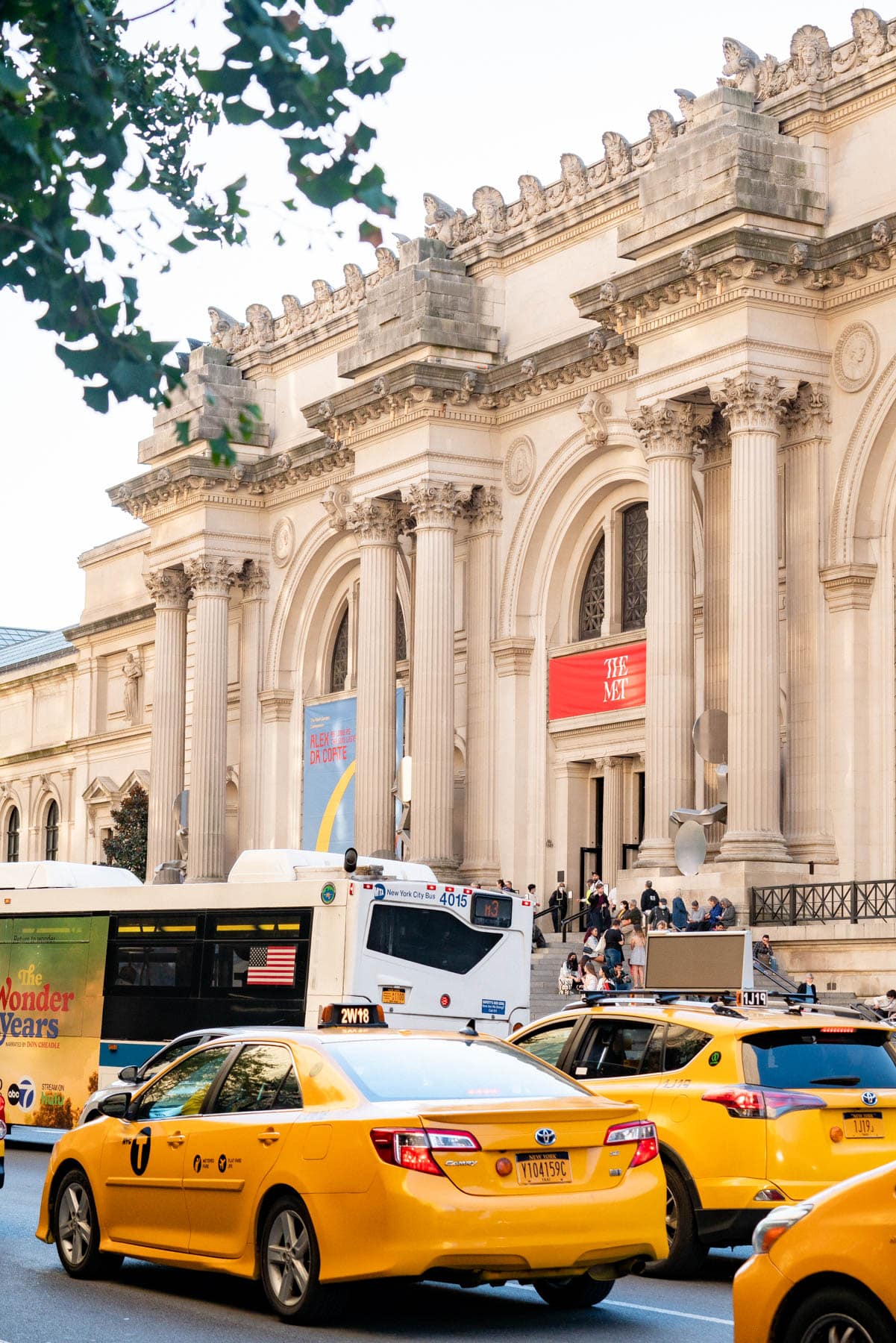
This list of the best art to see at the Metropolitan Museum of Art was written by Antonina Pattiz, founder of New York Simply (an official NYC partner of Apple Maps).
One of my favorite things about living in New York City is having daily access to world-class museums. I’ve been to all of the city’s best museums, but none have impressed me more than the Metropolitan Museum of Art (The Met). Keen to explore every inch of this masterpiece, my husband and I purchased memberships 3 years ago and have been visiting most Sundays ever since (100+ times!).
Home to more than 2 million pieces of art spanning 5,000+ years, the Met is the largest museum in the country and the fifth largest museum in the world. Suffice it to say: there’s no way you can see everything during your first visit to the Met, so there’s no sense in rushing the experience. However, there are a few things you should prioritize during your visit. On that note, allow me to share my personal list of the best things to see at The Metropolitan Museum of Art. Let’s get to it!
Visiting New York City? If you haven’t decided where to stay (yet) check out our helpful guide on Where to Stay in New York City (The 10 Best Neighborhoods for First Time Visitors & 3 to Avoid). Don’t have time? Here’s my favorite hotel in NYC, hands down.
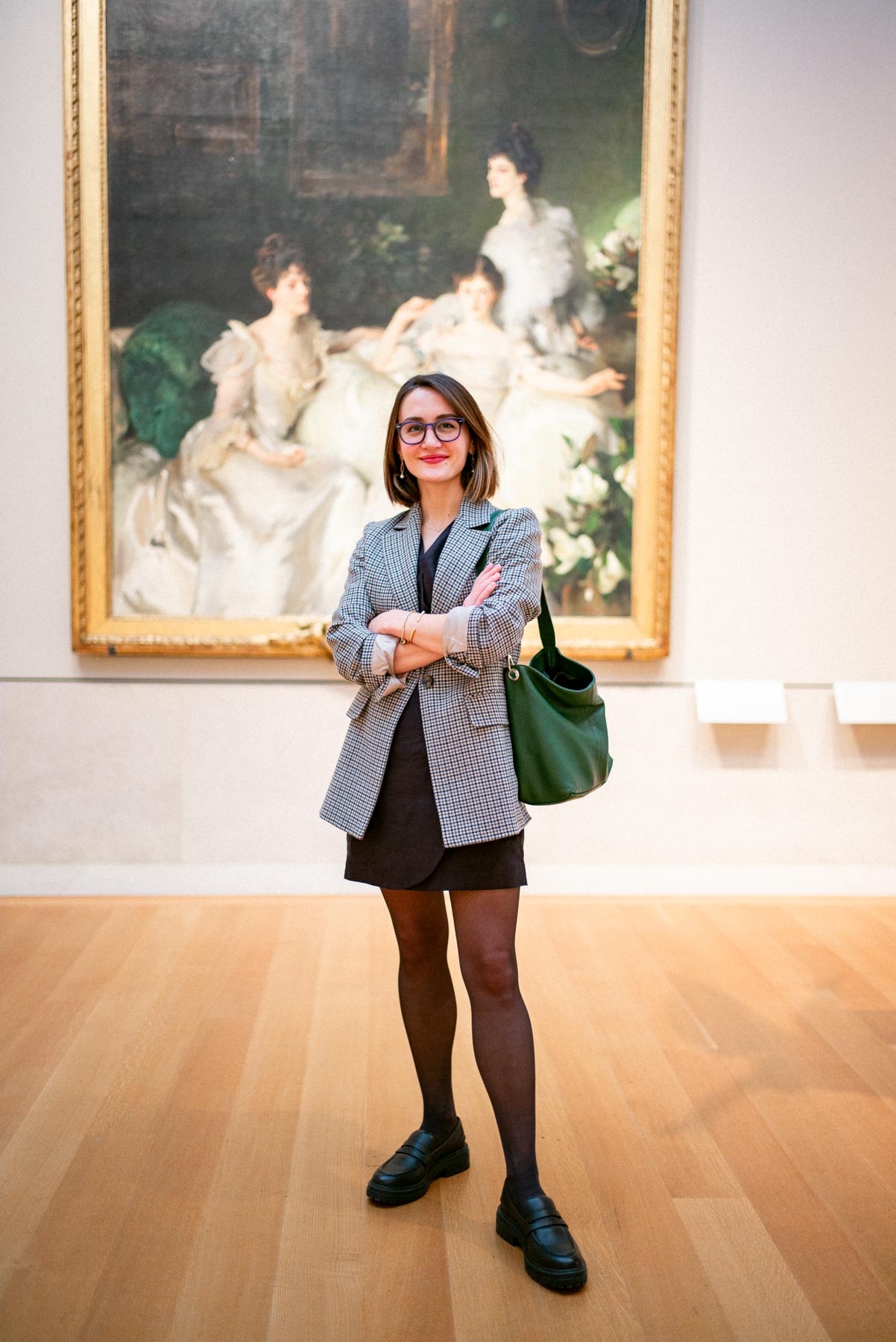
Tips for Visiting The Met
Don’t rush the experience
As mentioned, this is the fifth largest museum in the world and there’s no way you’re going to scratch the surface during your first visit to the Met. Enjoy your time slowly, read the signs, learn about the artist and study the art. Give yourself permission to slow down, use this experience as an escape from the bustle of the city and you’ll be set for success.
Crowds are guaranteed
The Met averages 6 million visitors per year, which means crowds are all but guaranteed (especially during rainy days and weekends). My best advice is to show up around opening time and have a game plan for the things you must see at The Met (you can use the list below for guidance).
The layout of the museum
The Met spans four floors and includes a rooftop terrace that offers some of the best views of New York City. This handy interactive map will make it easier to get a lay of the land.
Love museums? You may enjoy: 15 EXCITING Museums in New York City (& What to See at Each)
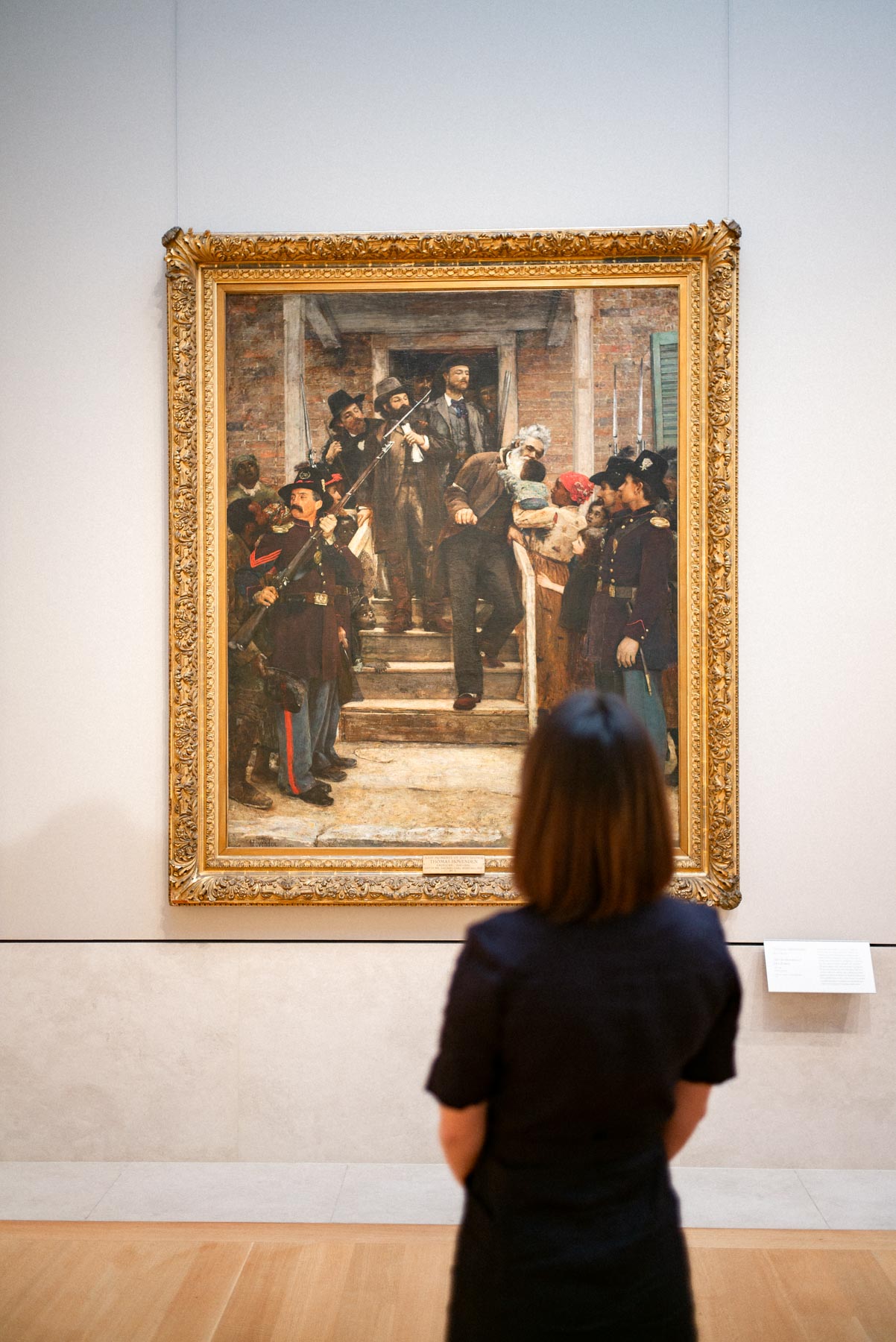
Best Things to See at The Metropolitan Museum of Art
(Table of Contents)
Famous Art at the Met (Table of Contents)
- Tips for Visiting The Met
- Best Things to See at The Metropolitan Museum of Art
- First, Let’s Cover The Most Famous Paintings at the MET
- Self Portrait with a Straw Hat
- Washington Crossing the Delaware
- The Death of Socrates
- The Denial of Saint Peter
- The Dance Class & Little Dancer
- Rembrandt Self-Portrait
- Aristotle with a Bust of Homer
- Bridge Over a Pond of Water Lilies
- A Study of A Sunday on La Grande Jatte
- The 5 Paintings by Vermeer
- Garden at Sainte-Adresse
- Must- See at the Metropolitan Museum of Art (Apart from Paintings)
- Have More Time? More Great Things to See at The Met
- List of Famous Art at The MET in New York City (Post Overview)
- What to See at The Met in 2 Hours
- Visiting the Met (FAQs)
If I had to choose a single destination where I’d be held captive for the rest of my time in New York, I’d choose the Metropolitan Museum of Art.
Tim Gunn
First, Let’s Cover The Most Famous Paintings at the MET
I thought it’d be helpful to break this list down into two categories: paintings + all other stuff. Since most folks end up visiting the Met for famous art, let’s cover the most famous paintings at The Metropolitan Museum of Art first. Afterwards, I’ll go over the other incredible things you should try to see.
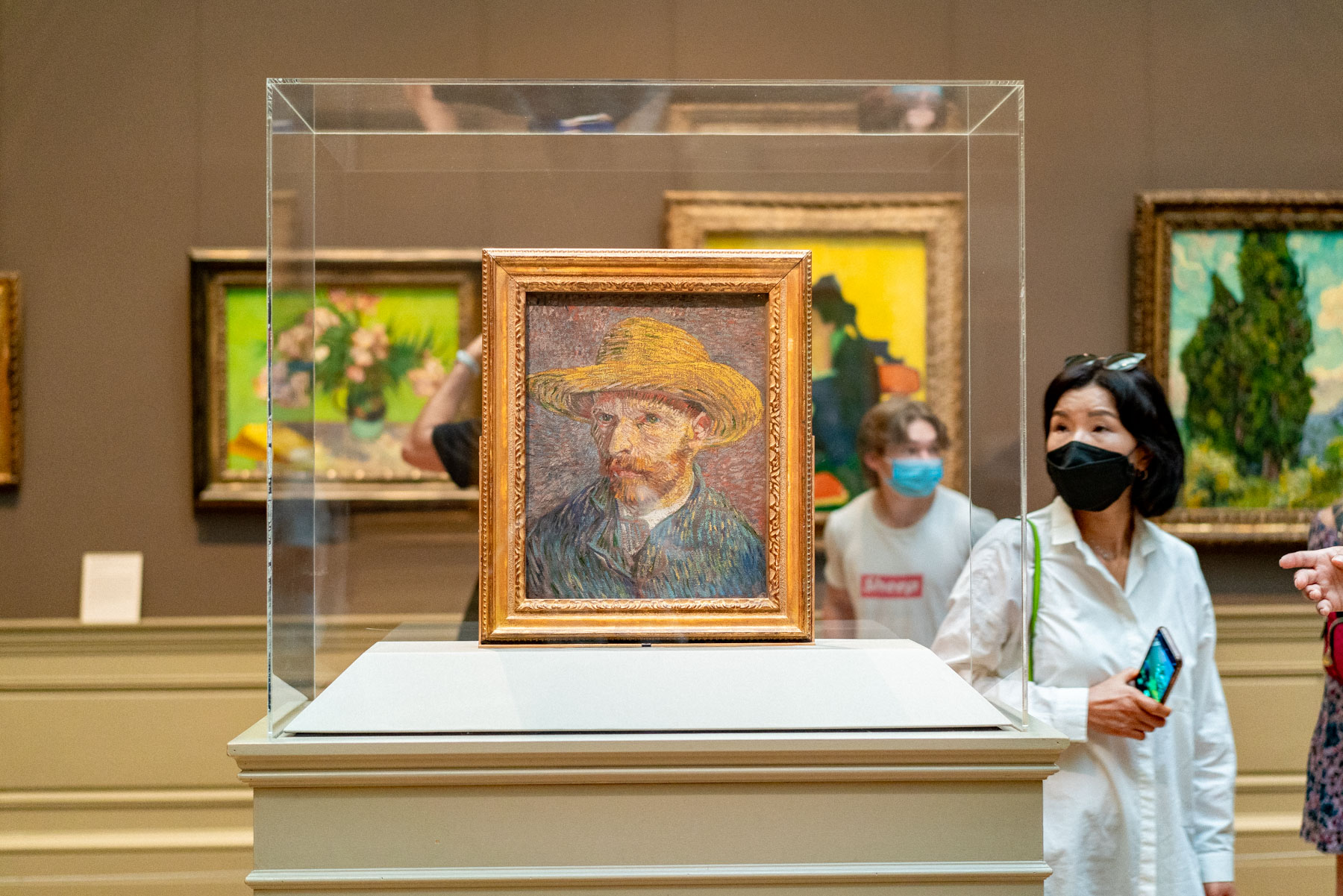
Self Portrait with a Straw Hat
Marked by van Gogh’s signature Neo-Impressionist technique and mastery of color, Vincent van Gogh’s Self Portrait with a Straw Hat is intriguing. Van Gogh painted more than twenty self-portraits during his time in Paris, in the hopes of perfecting his skills. He couldn’t afford a model, so he used a mirror instead.
Take your time admiring this work before walking around to the other side. On the reverse side you’ll find The Potato Peeler, a painting done during van Gogh’s studies of peasants (marred by dark shadows and heavy tones, the painting feels much sadder than his self-portrait).
You might be wondering why there’s two paintings on one frame. Well, van Gogh was so poor that he had to re-use frames. It might be hard to believe this now, but van Gogh wasn’t successful in his lifetime and died in poverty. If only he could know that his self portrait is one of the most famous art pieces at the Metropolitan Museum of Art.
“I purposely bought a good enough mirror to work from myself, for want of a model.”
Vincent Van Gogh
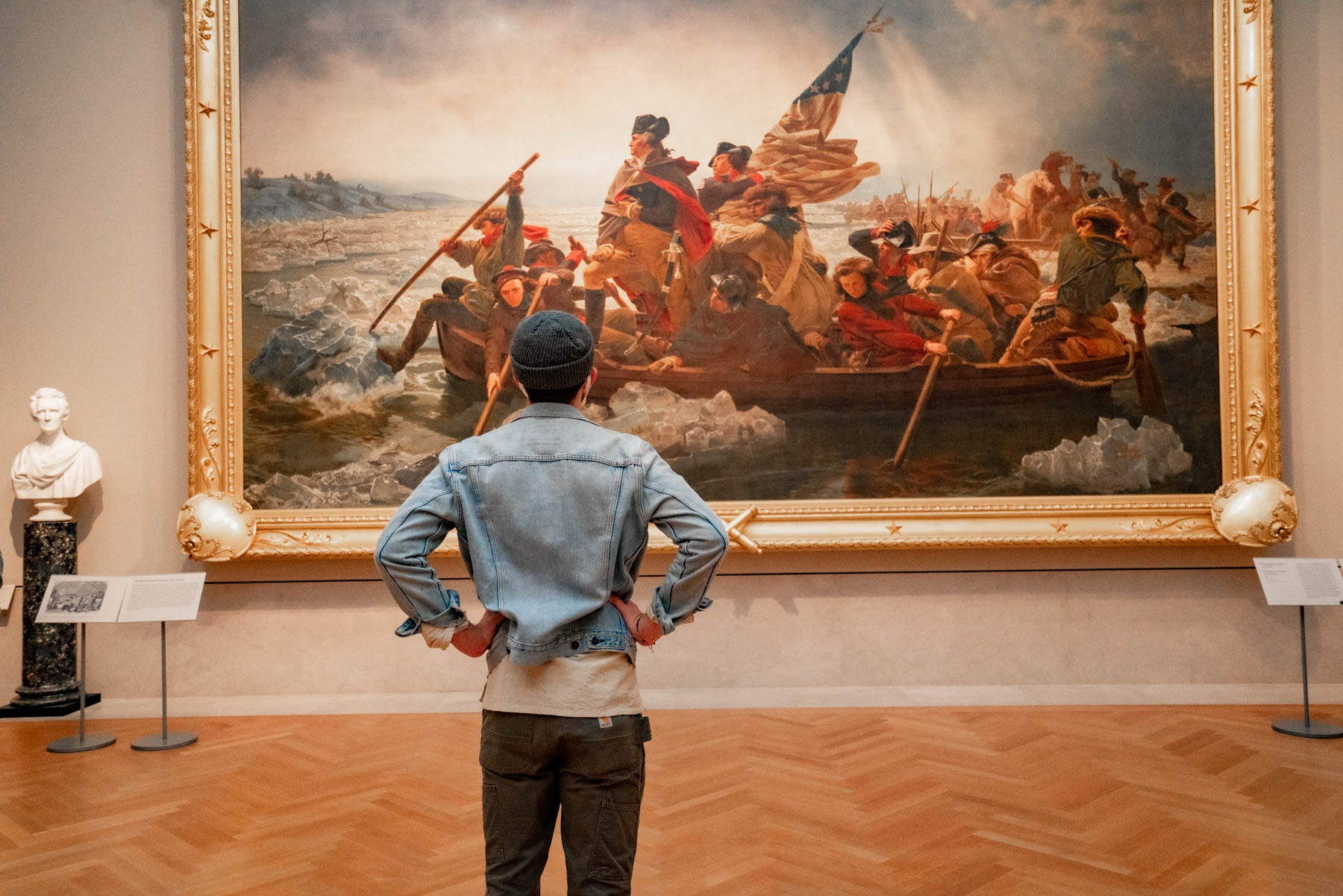
Washington Crossing the Delaware
The painting of Washington Crossing the Delaware commemorates the night of December 25-26, 1776, when General George Washington and the Continental Army crossed the Delaware River during the Revolutionary War.
This was the first surprise attack (and subsequent victory) against Hessian forces (German soldiers serving in the British Army) at the Battle of Trenton. It was a huge victory in America’s fight for independence. Leutze produced three versions of this famous painting, but only two survived.
The first version was damaged in a studio fire and was promptly restored only to be destroyed in a bombing raid during World War II shortly thereafter. Of the two surviving versions, one is housed at The Met and the other was displayed in the West Wing of the White House, (before being moved to the Minnesota Marine Art Museum in 2015).
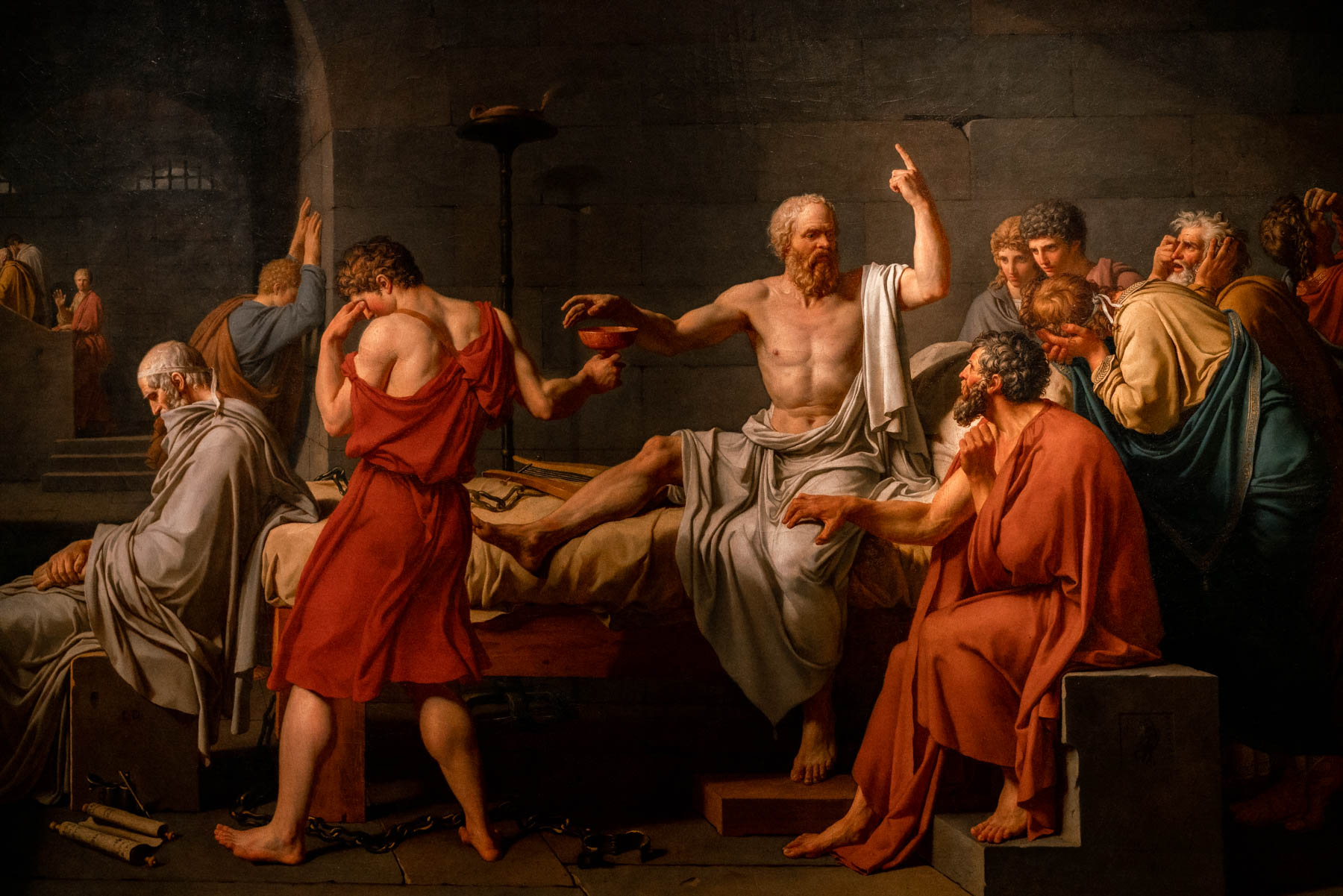
The Death of Socrates
The story of Socrates is taught all over the world, but as with most things, it’s easy to forget the details, so here’s a quick refresher:
Socrates (470-390 BC) was a venerable philosopher beloved by some and despised by others. He shared his wisdom freely, but was later accused of corrupting the youth and usurping the gods. As punishment, he was given two options: renounce his ideologies or die by hemlock. Socrates said something along the lines of “no takesy backsies” and pointed to the hemlock.
French artist Jacques Louis David painted the profound scene in a piece he titled The Death of Socrates. The painting is based on Plato’s somber record of the event. The portrait illustrates Socrates’ determined final moments, as he reaches for the hemlock while his disciples watch on in despair and anguish.
The painting is one of the most famous art pieces at The Met and it’s not hard to see why. Expertly painted, it can be mistaken for a photo. The play on light is also worth calling out, it’s a masterpiece.
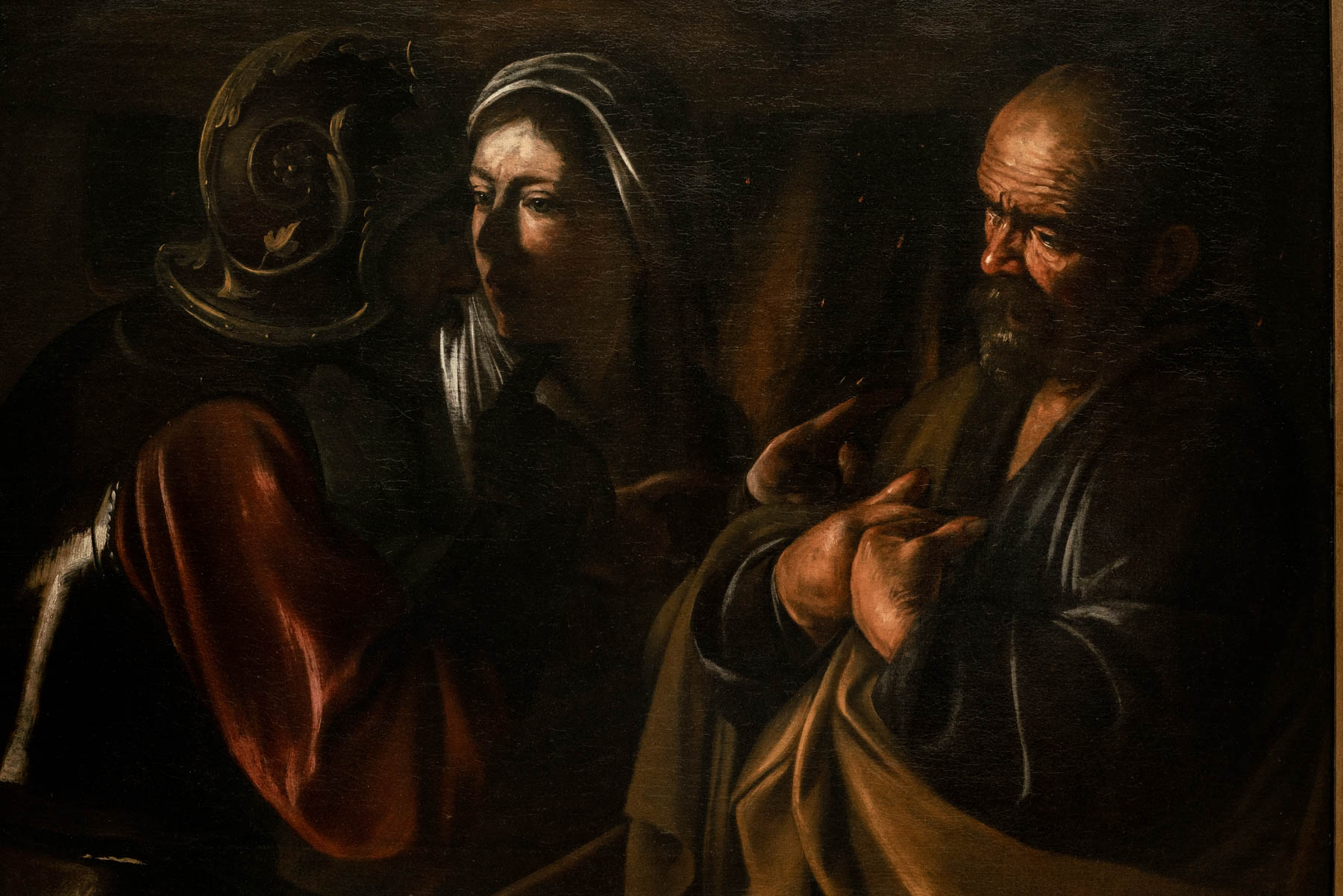
The Denial of Saint Peter
The biblical story of Saint Peter is riddled with deceit and betrayal. Peter betrayed Jesus three times, and his denial is depicted in this famous painting by Italian painter Caravaggio. Carvaggio’s style is unique due to his mastery of light and (heavy) shadows. The eye is encouraged to go exactly where Carvaggio intends (Peter’s complicated emotions).
The profound painting is full of symbolism. You may notice the three fingers pointing at Peter, this alludes to the three times he betrayed Jesus. You don’t need to be an art connoisseur to appreciate this famous painting at the Met.
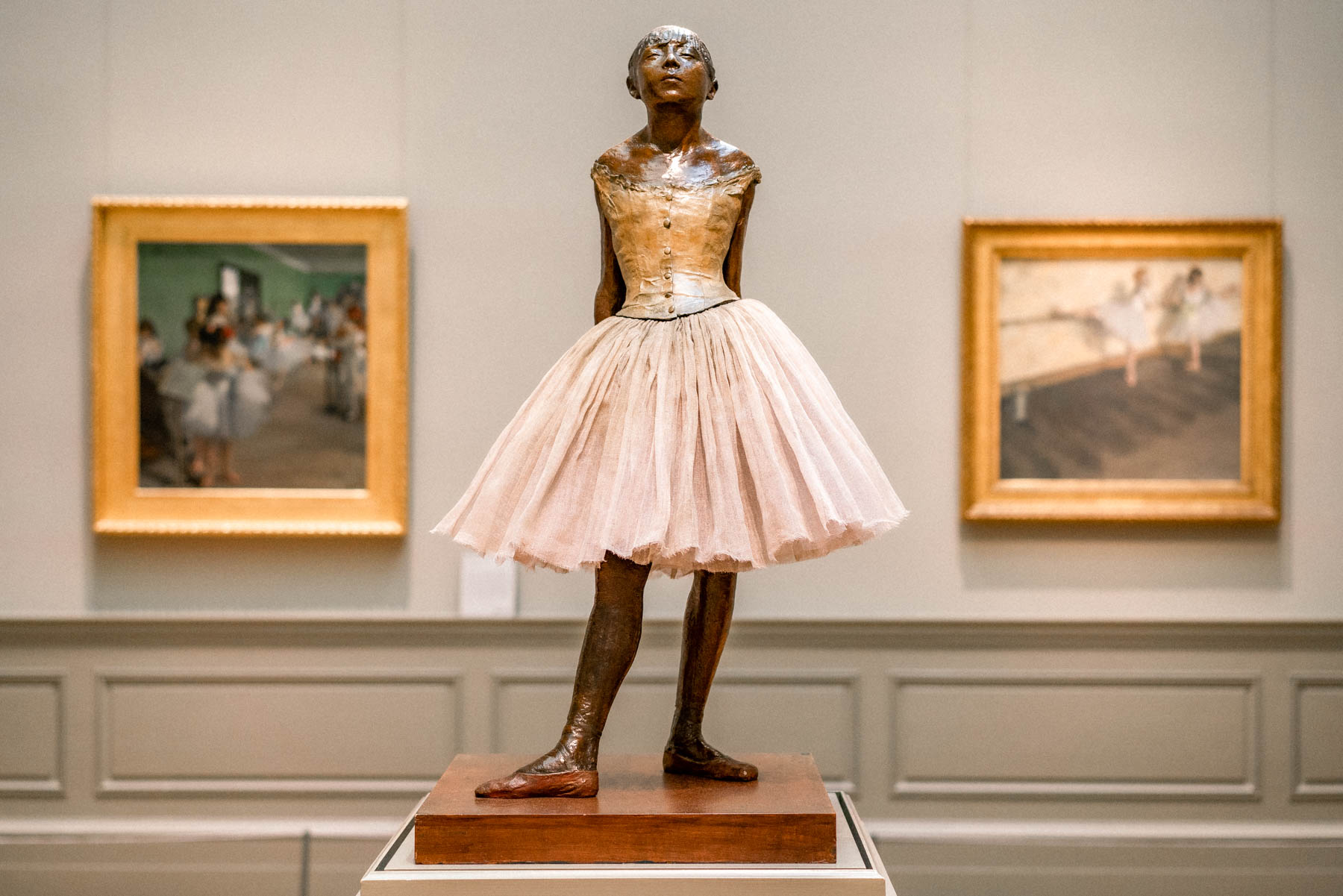
The Dance Class & Little Dancer
Painted by Edgar Degas, you may have seen photos of The Dance Class in your old school textbooks. This famous MET painting highlights a group of ballerinas alongside their mothers, anxiously waiting on a ballerina’s examination while the instructor watches on.
The opulent Paris Opéra serves as a backdrop (sadly, the building burned down a year before the painting was complete). This painting, and its companion piece at the Musée d’Orsay, are considered Edgar Degas’ most ambitious works (on the theme of ballet).
Degas was both a talented painter and remarkable sculptor. You’ll find a beautiful statue of a ballerina, called Little Dancer of Fourteen Years, in the same room as The Dance Class. Take some time to admire the sculpture and try to figure out the story behind her facial expression.
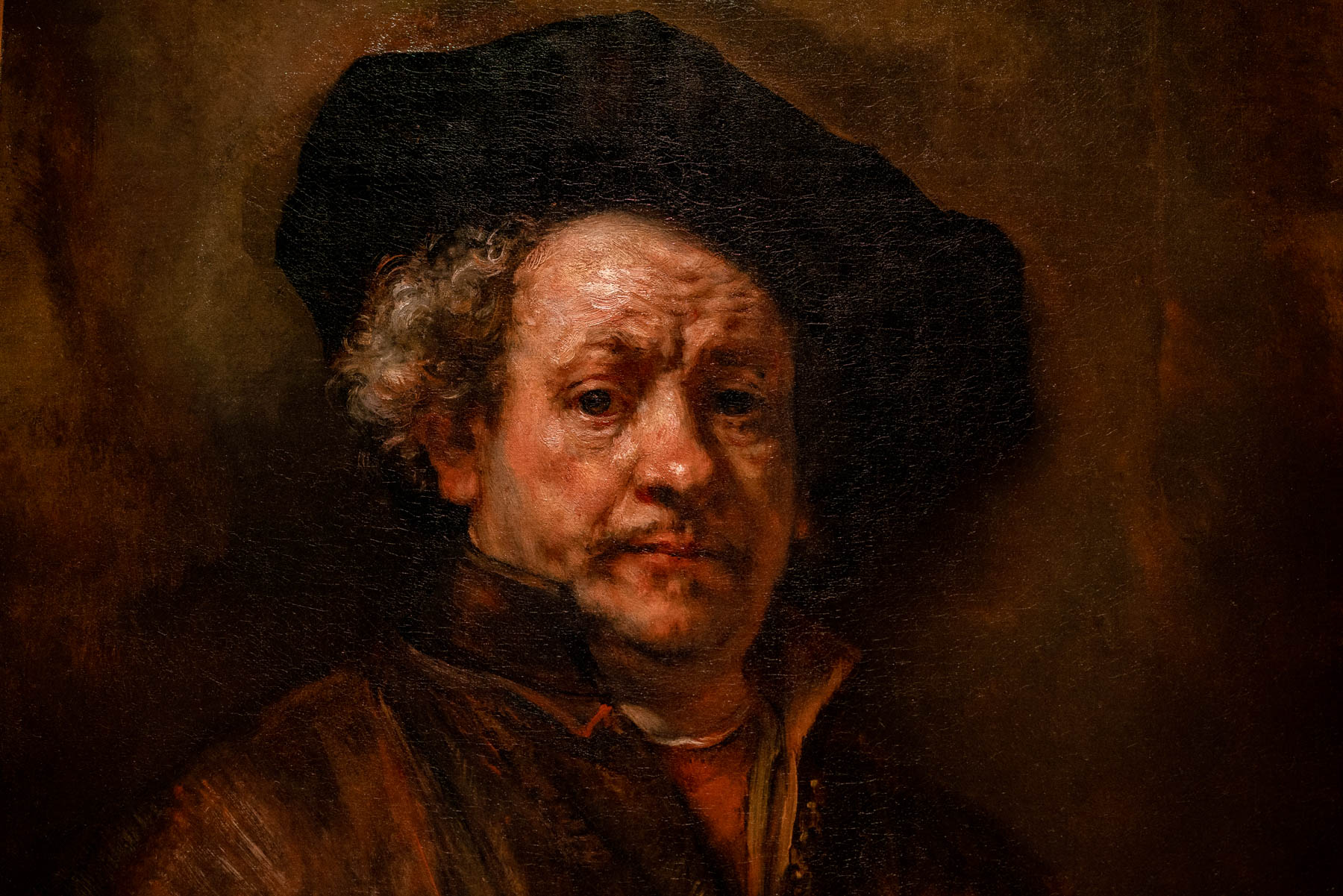
Rembrandt Self-Portrait
I think it’s safe to say that Rembrandt needs no introduction. This world-class Dutch painter is well known even among folks that don’t know much about art (myself included). His mastery of portraits is undisputed, perhaps because he dedicated his life to perfecting the self-portrait.
It’s estimated that Rembrandt created around 80 self-portraits (and approximately 40 to 50 paintings), in his lifetime. Of that, only 40 self portraits survived and the Met is lucky to have one. This famous painting was completed in 1660, when Rembrandt was 54 years old.
The wrinkled brow and sorrowed eyes give away the artist’s aging face and allude to the contemplative nature of his maturing mind. I find it fascinating that Rembrandt didn’t romanticize his appearance in a narcissistic fashion, but chose to be honest about his aging features. This is one of my favorite paintings at the museum, which is why I consider it one of the must-see paintings at The Met.
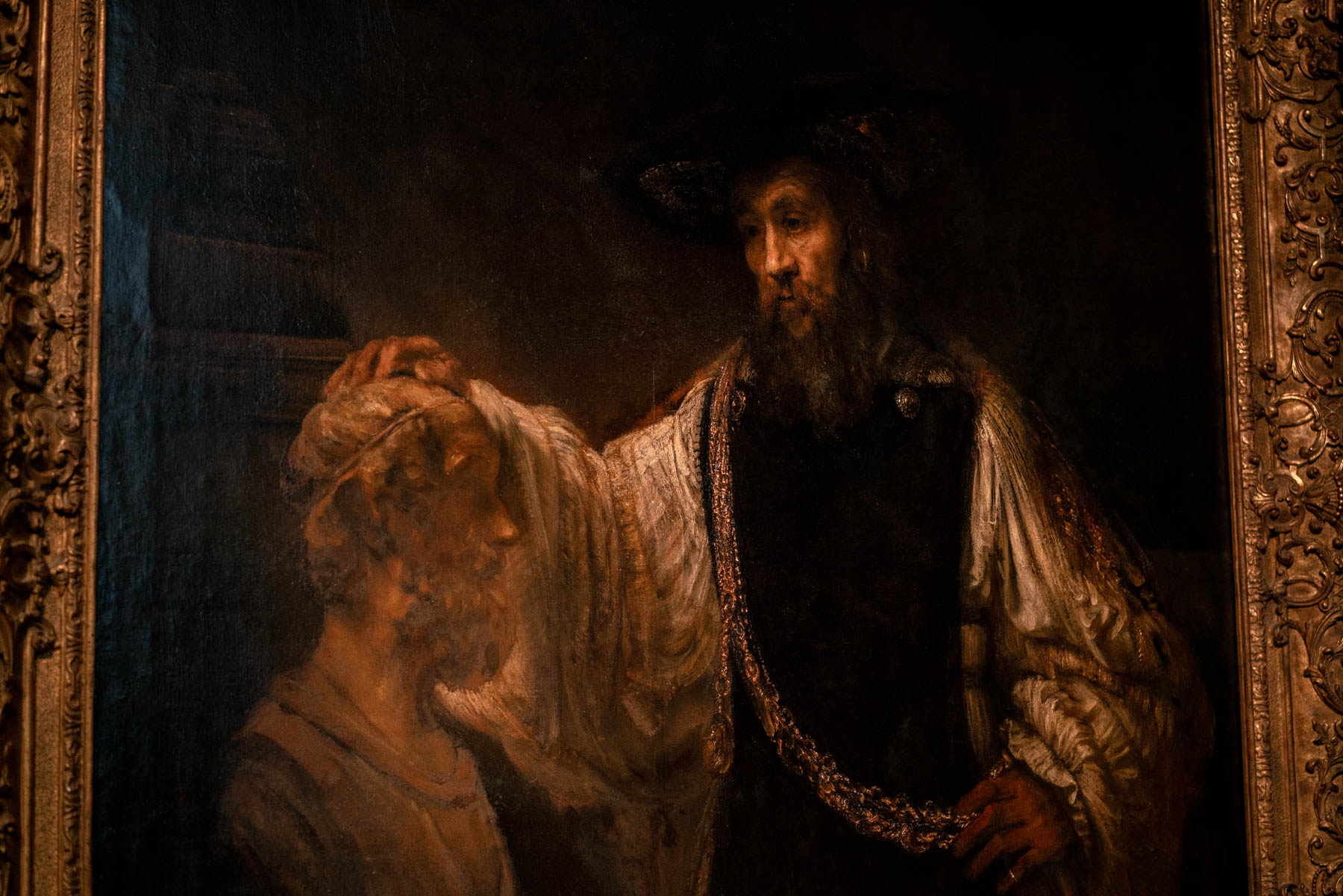
Aristotle with a Bust of Homer
Sticking to the theme of Rembrandt masterpieces, Aristotle with a Bust of Homer is also a must see at The Met. Thankfully it’s located a few steps from Rembrandt Self Portrait, making it a natural next stop.
This iconic painting is considered one of the most celebrated and famous paintings at the Metropolitan Museum of Art, reason alone to visit. The portrait depicts a pensive Aristotle resting his hand on a bust of Homer, the legendary poet that achieved literary immortality through his writing of Iliad and Odyssey.
Aristotle looks contemplative, which leads historians to assume Rembrandt was meditating his own legacy and the meaning of fame. This is a large piece of work that stays true to Rembrandt’s classic style of thick strokes and dark shadows, demanding careful study.

Bridge Over a Pond of Water Lilies
Monet was a man of many passions, most notably art and horticulture (his world-famous paintings shine a light on his adoration for nature). Bridge Over a Pond of Water Lilies is no exception. Monet purchased some property in Giverny, France and found himself smitten by the pond. From this little slice of heaven he painted his famous collection of water lilies.
Monet’s paintings can be viewed at notable museums all over the world, some folks even challenge themselves to see as many as they can. As such, don’t miss an opportunity to see Bridge Over a Pond of Water Lilies, one of the most famous art pieces at the Met.
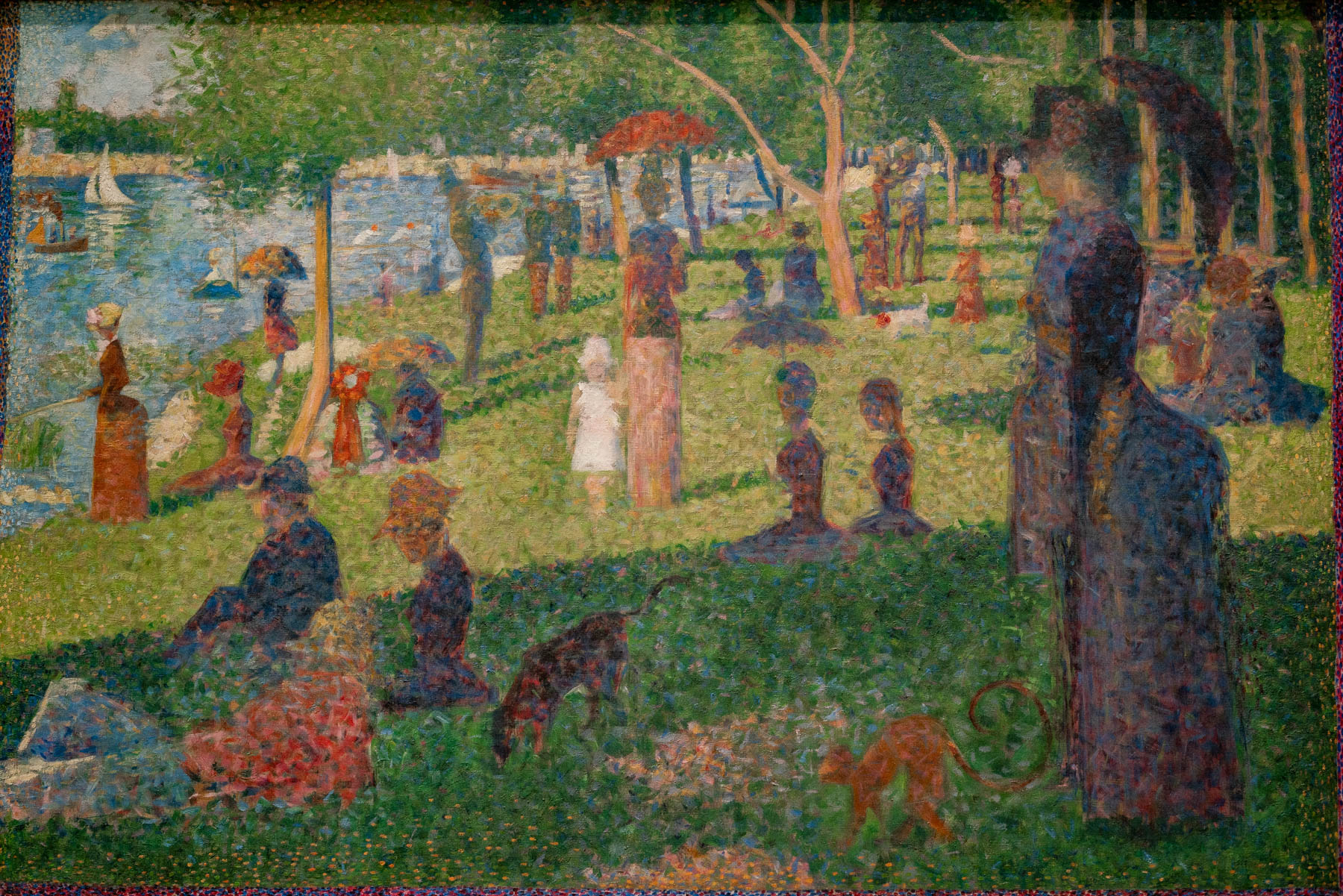
A Study of A Sunday on La Grande Jatte
A Sunday on La Grande Jatte is considered Georges Seurat’s finest work. It depicts a peaceful scene of Parisians leisurely enjoying a sunny day along the banks of the Seine River. What makes this famous Met painting unique is the technique used.
Look closely and you will notice the entire painting is comprised of tiny dots, which give the illusion of blending together when viewed from a distance. This technique was invented by Seurat and came to be known as Pointillism (from the French word for dot, point).
Seurat himself preferred the term Divisionism because he saw the method as separating colors into small touches that when placed side-by-side would appear to blend together. As you can imagine, this famous painting took a lot of work!
However, the effort paid off because A Sunday on La Grande Jatte is considered the most remarkable painting of the 19th century, making it one of the most famous paintings at The Metropolitan Museum of Art.
Something to note: Seurat completed several “trials runs” at creating the painting. The official masterpiece is located at the Art Institute of Chicago. The Met houses the smaller (but still complete!) painting of A Sunday on La Grande Jatte.

The 5 Paintings by Vermeer
Vermeer was not well known during his lifetime and only 34 surviving paintings are confirmed to be his. The Met is home to five Vermeer paintings, more than any other museum in the world.
It seems that Vermeer fell into obscurity and wasn’t appreciated until the end of the 19th century. But now there’s a newfound appreciation for the artist and serious art connoisseurs make an effort to seek out his paintings. All five paintings are displayed side-by-side, giving you ample time to admire Vemeer’s mastery of light.
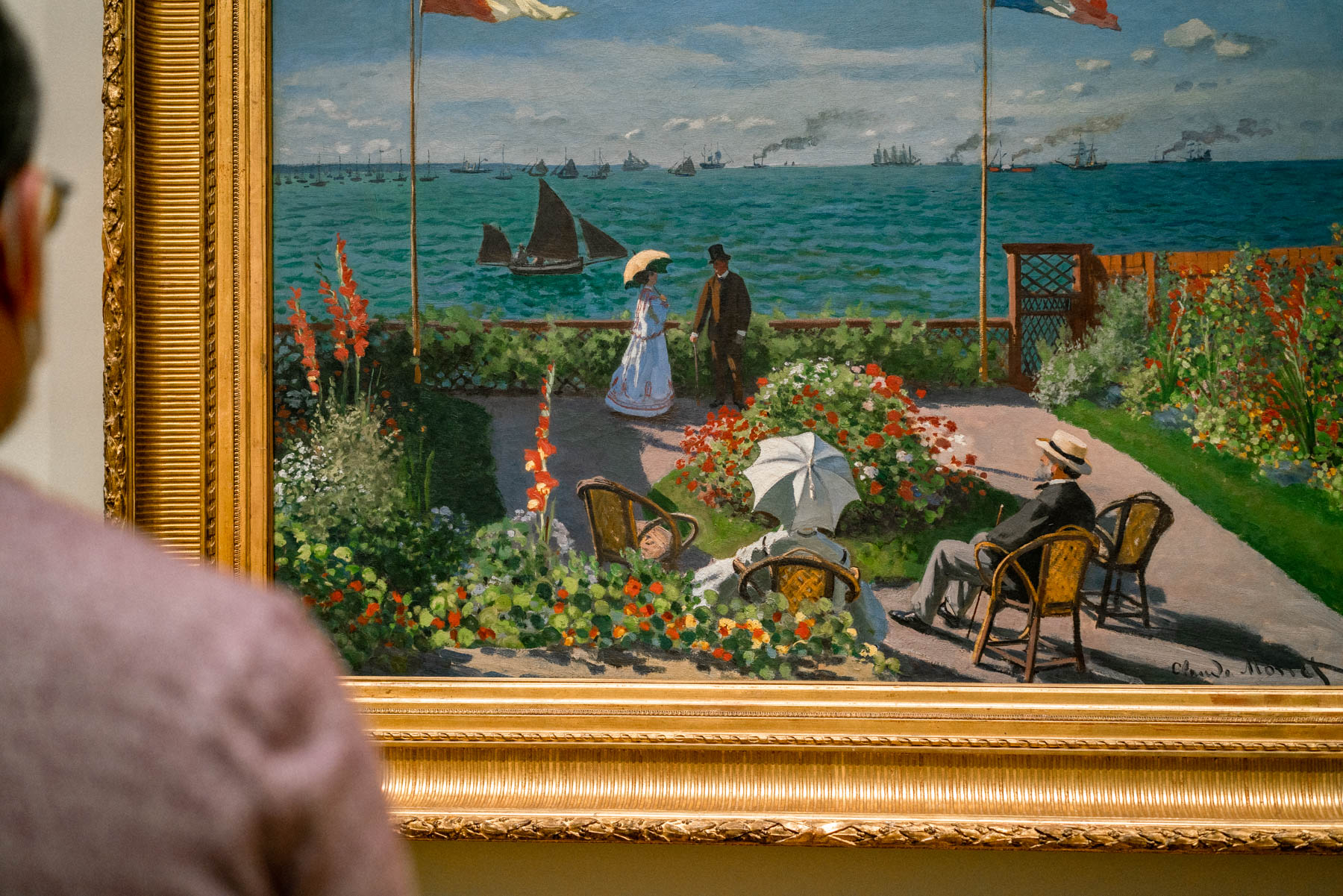
Garden at Sainte-Adresse
I’ve mentioned Monet’s most famous painting at The Met: Bridge Over a Pond of Water Lilies, but allow me to share my personal favorite painting by the artist, Garden at Sainte-Adresse.
Monet spent the summer of 1867 in the resort town of Sainte-Addresse with his family. He ended up painting a few pieces, but my favorite of the bunch is this sunny scene of leisurely French life. He used his family members as models (his father wears the panama hat).
This painting feels vastly different from Monet’s typical work and speaks to his adoration for Japanese art. The colors are more vivid and the scene feels obnoxiously cheery (even though the reality was not). Monet’s relationship with his father was tense because he disproved of Monet’s fiance. But alas, you wouldn’t know it based on this beautiful Met painting.
Must- See at the Metropolitan Museum of Art (Apart from Paintings)
A common mistake some people make when visiting the Met for the first time is assuming the museum is mostly full of paintings. That’s not the case! On the contrary, paintings are only half of the things you must see at The Met. You’ll find everything from vintage shoes, rare books, fascinating furniture, Egyptian relics and actual armor, among other things. Now that we’ve covered the most famous paintings at the Met, let’s take a look at the other must see things at the Met (and why they’re important).
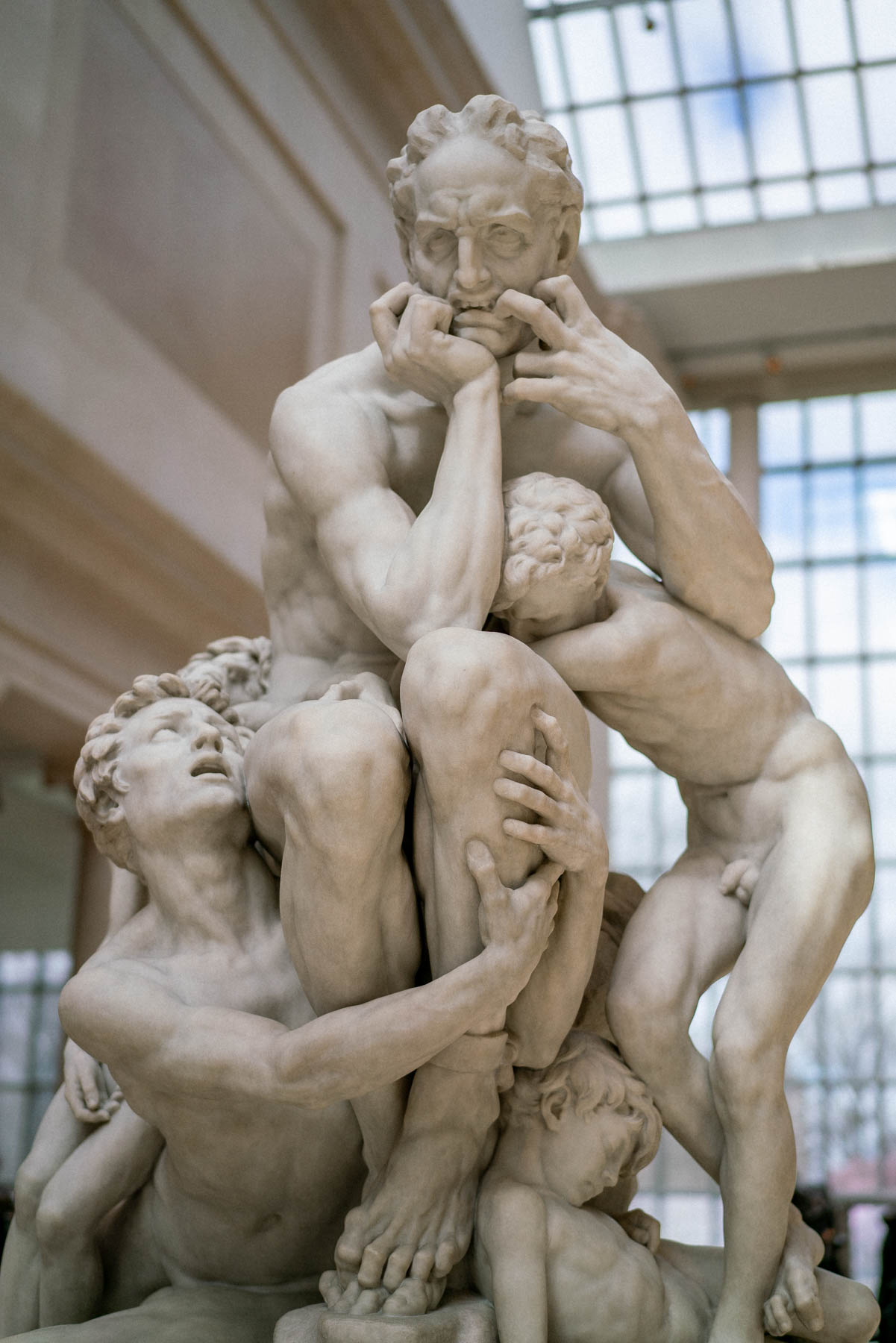
Ugolino and His Sons
Ugolino and His Sons is a marble sculpture that evokes a devastating sense despair and torment. Produced by Jean-Baptiste Carpeaux, the scene is derived from Dante’s Inferno, which describes Ugolino della Gherardesca’s imprisonment in 1288.
Ugolino (a real man) was an Italian nobleman and politician. He was the head of the prominent Guelph family in Pisa, but his legacy is one of betrayal and tragedy. Ugolino was accused of treason and was imprisoned with his sons and grandsons in the Tower of Hunger (Torre della Fame) in Pisa. The keys were thrown away, and they were left to starve to death.
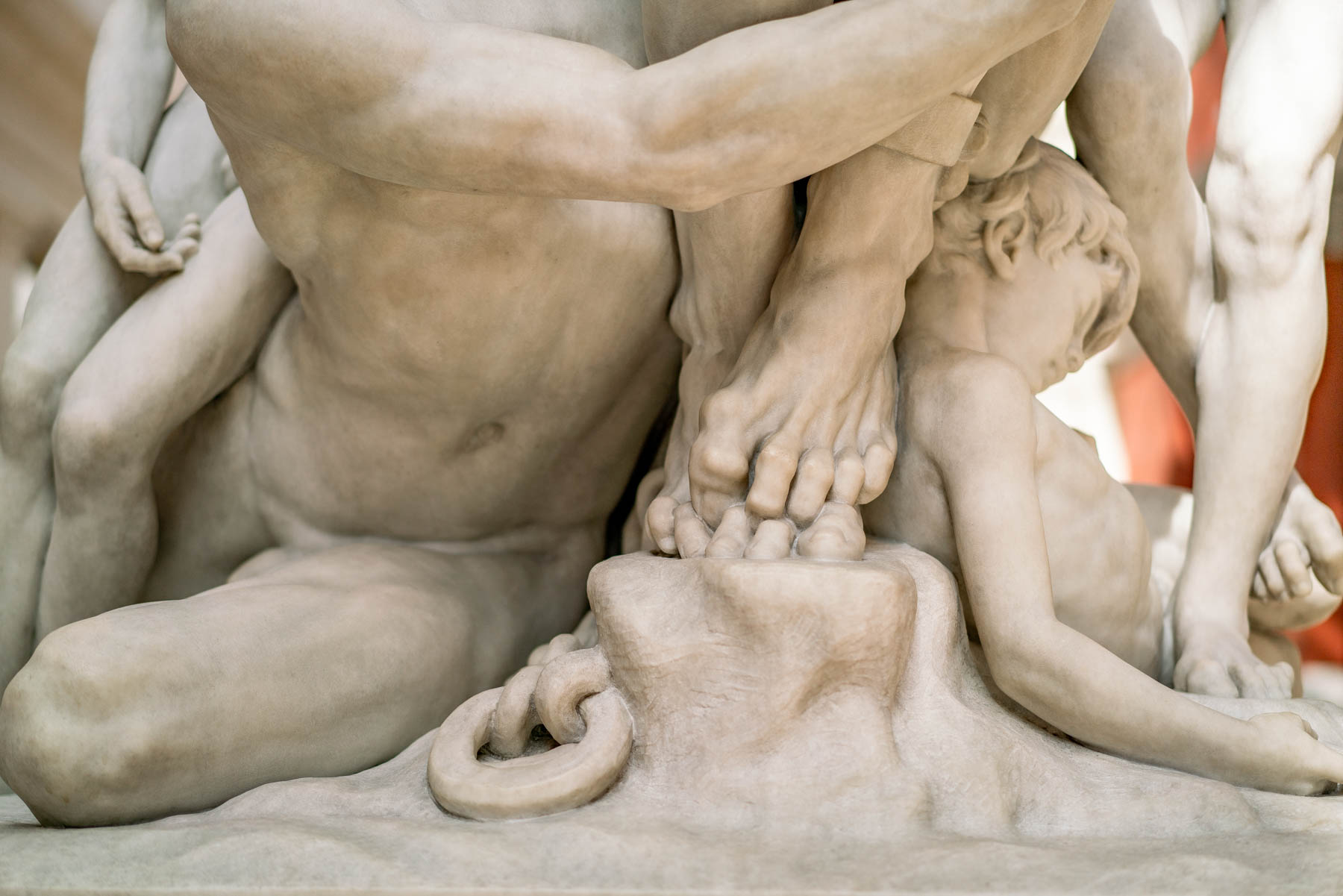
Dante’s portrayal of Ugolino in the Inferno is gruesome and poignant. In Hell, Ugolino recounts to Dante the agony of his imprisonment and the deaths of his children, who (driven by hunger), begged him to eat their bodies.
It’s unclear if Ugolino subjected himself to cannibalism but some argue the statue depicts the exact moment Ugolino contemplated the notion. His anguished eyes look into a distant void, ignoring the youth that cling to his feet.
Morbid, to be sure, but there’s no denying that Carpeaux is a talented sculpture, he depicts the desperation flawlessly. Inspired by Michelangelo, the artist’s obsession with anatomical realism is hard to ignore. In fact, the expressive detail in this sculpture of Ugolino and His Sons launched his career.
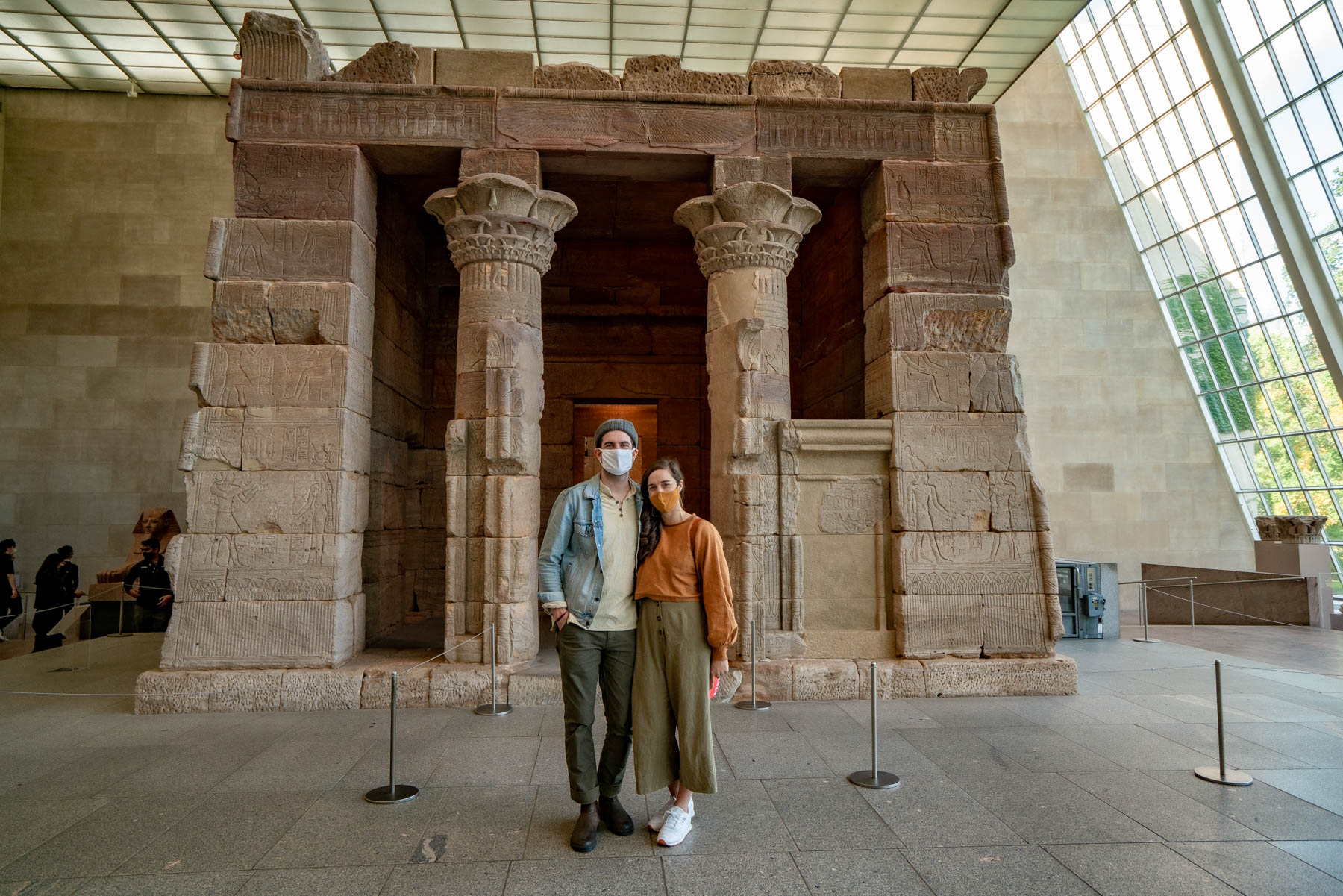
The Temple of Dendur
The Temple of Dendur is one of the best things to see at the Metropolitan Museum of Art. Why? Because it’s the only complete Egyptian temple in the Western Hemisphere.
The Temple of Dendur was built on the banks of the Nile River more than 2,000 years ago. But when the area was flooded by the building of the Aswan High Dam, efforts were made to save the temple from being submerged and destroyed. The temple was disassembled brick-by-brick (imagine!) and brought over to the United States.
It was reassembled and opened to the public in 1978 in a specially designed wing of the museum, the Sackler Wing. The exhibit resembles the temple’s original location on the banks of the Nile River, complete with a reflecting pool and a background that simulates the natural environment around the Nile.
This temple was a gift from Egypt in recognition of the United States’ significant contributions to the UNESCO-led campaign to save numerous historic sites from being submerged during the construction of the Aswan High Dam. I consider the Temple of Dendur a must see at The Met for first time visitors.
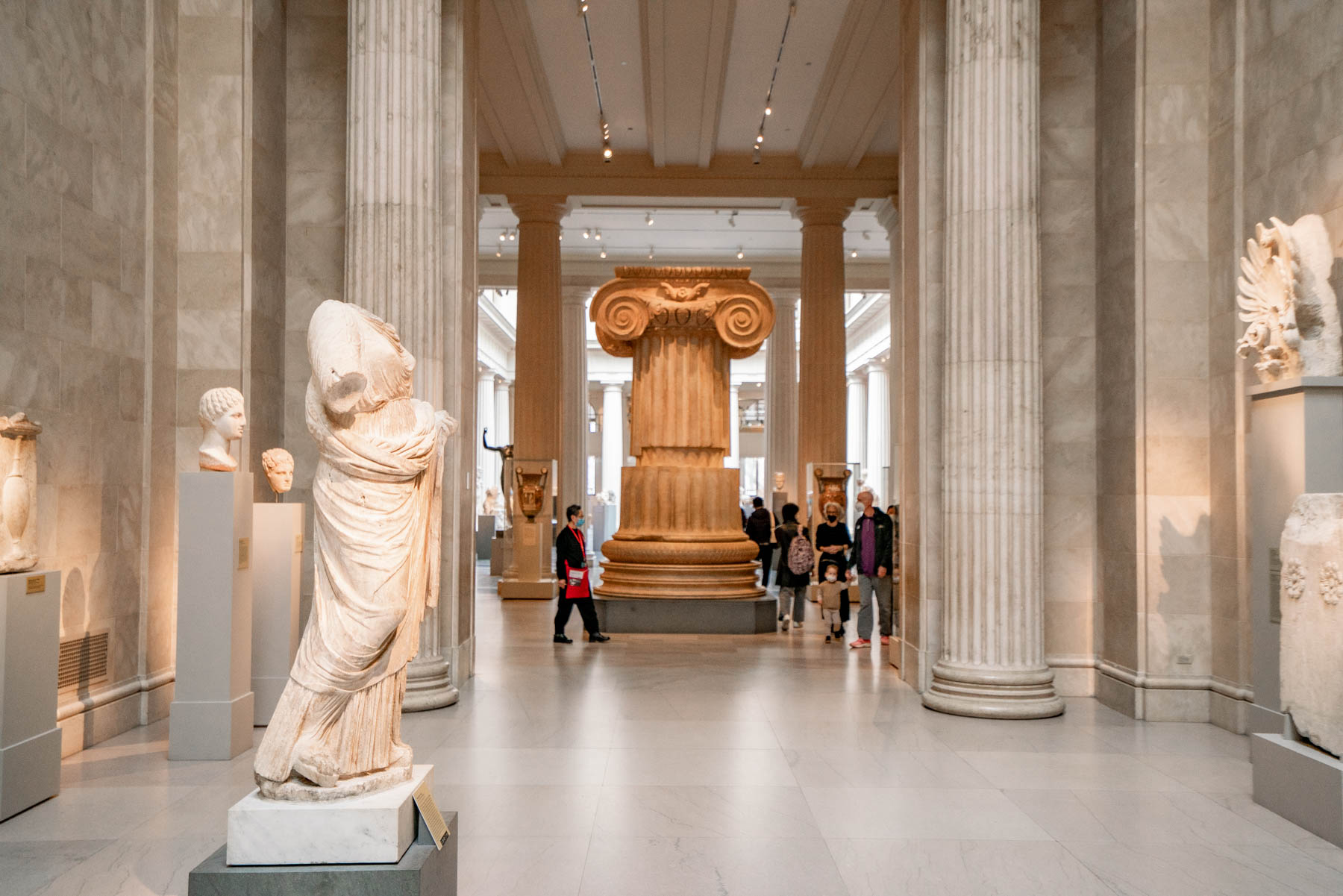
The Greek and Roman Sculpture Court
Swing by the Greek and Roman Sculpture Court to find yourself engulfed in a sea of breathtaking marble sculptures. Home to more than 30,000 works dating between 4500 B.C. to A.D. 312, the sculpture court is a must see at The Met.
Notable statues include:
- Marble statue of a wounded warrior
- Marble column from the Temple of Artemis at Sardis
- Marble Statue Group of the Three Graces
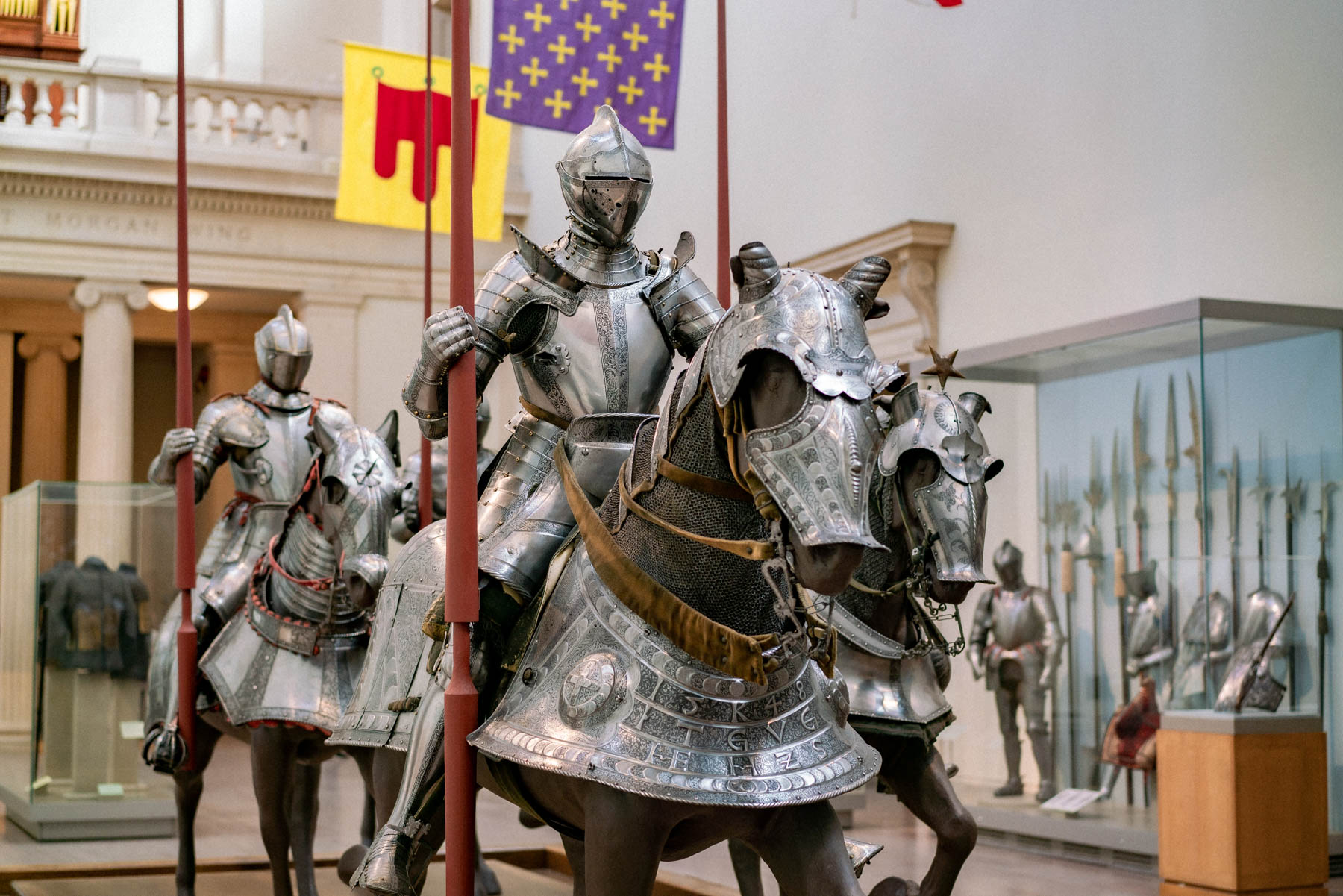
Arms and Armor
The Arms and Armor room at the Metropolitan Museum of Art is my husband’s favorite place to be on a rainy Sunday morning. Exploring the impressive armor feels like stepping foot into a time long forgotten.
The objective of the the Arms and Armor department is to preserve, research and exhibit the art of armor, swordsmiths and gunmakers. Lest we forget, armor and weapons were a source of pride. They required great technical capabilities and showed immense artistry in an effort to impress royalty.
Local’s Tip: Make sure to visit the musket room, the details on the guns are nothing short of amazing.
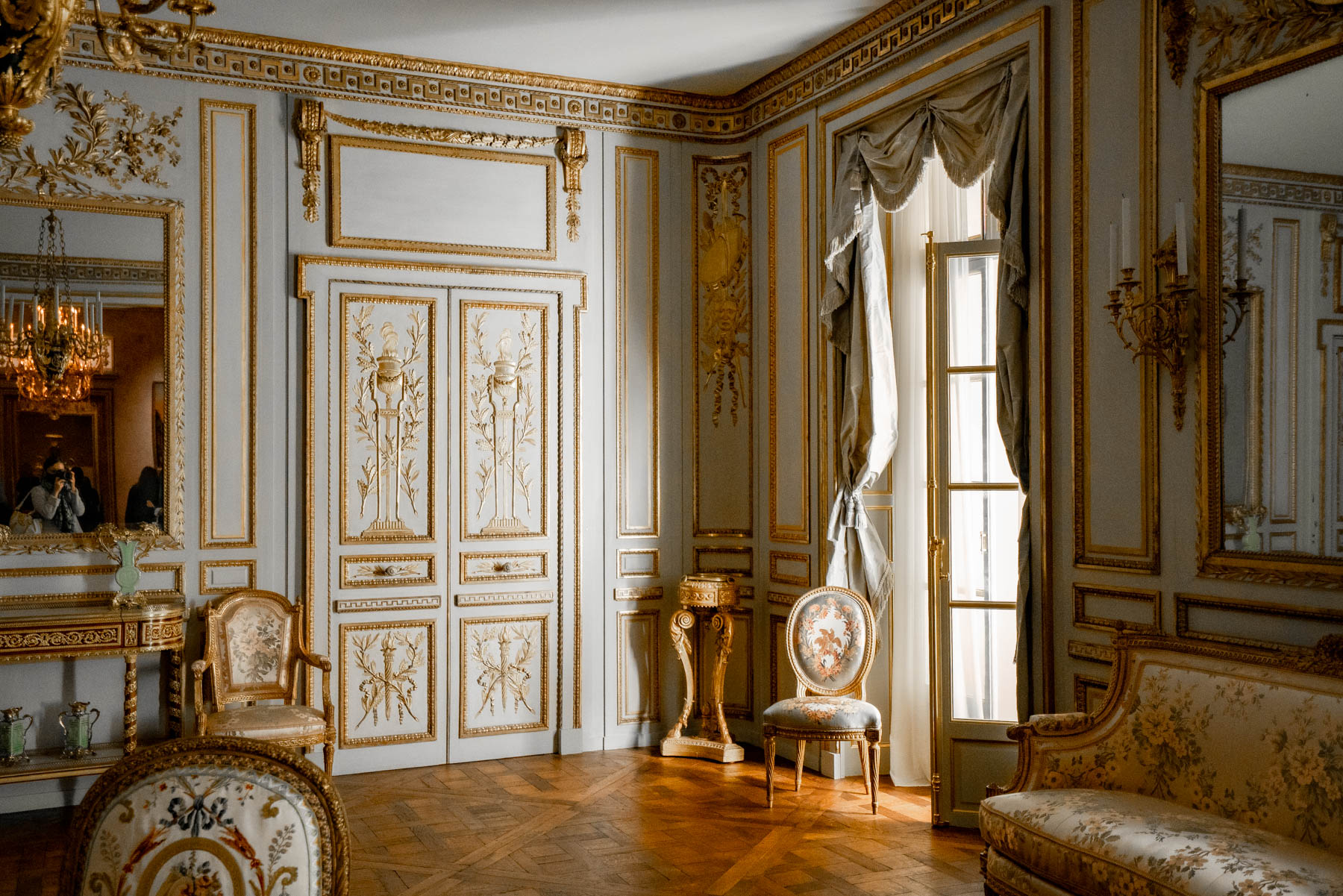
The French rooms from the Hôtel de Varengeville
One of the best things to see at the Metropolitan Museum of Art are the period-specific reconstructed rooms from the opulent Hôtel de Varengeville. These French rooms were used as private residences in 18th century Paris.
The details are mesmerizing, I highly recommend swinging by, especially for Francophiles, because this is one of the most enjoyable things to see at The Met.
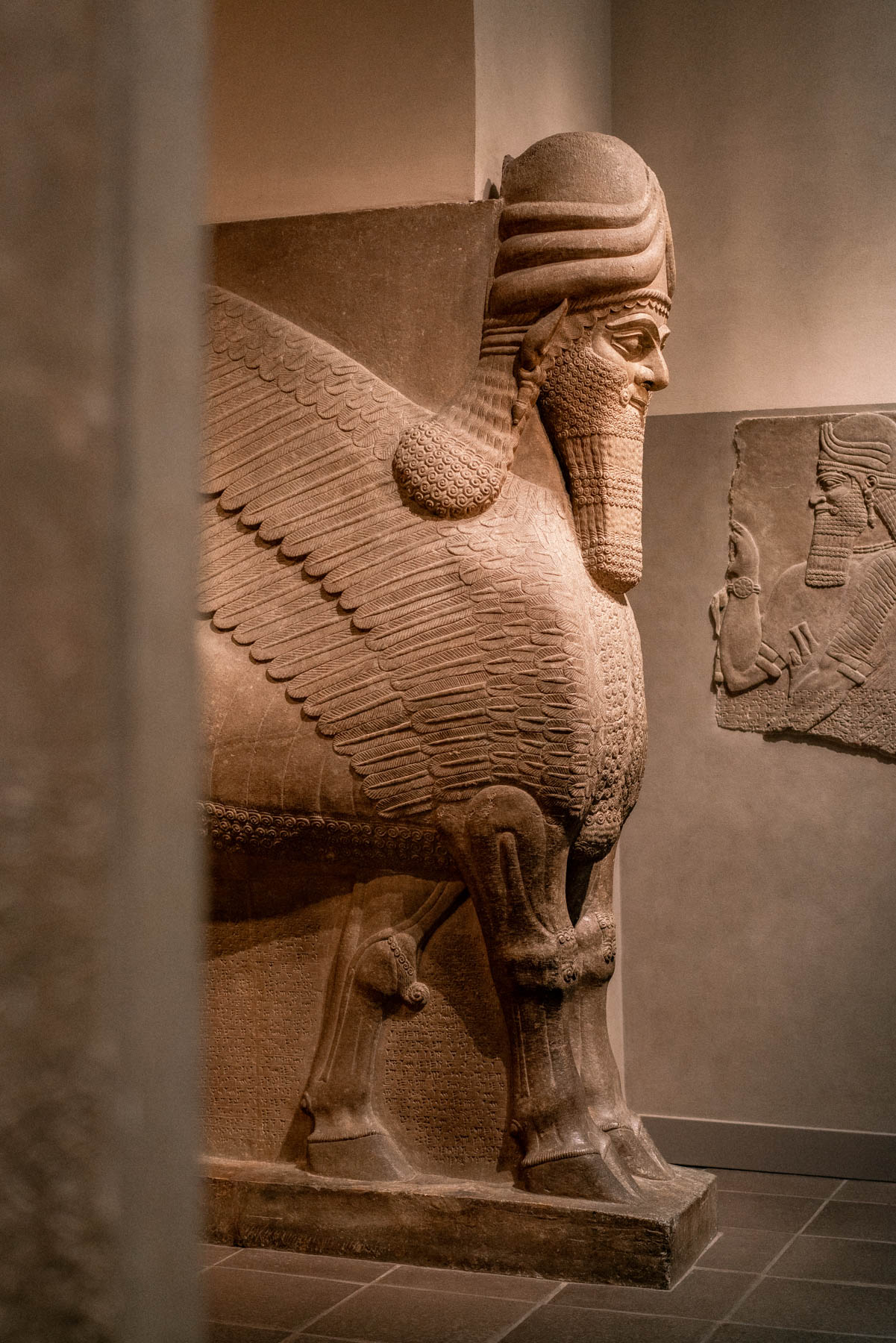
Human-Headed Winged Lion
Better known as Lamassu, these human-headed winged lions (which depict goddessed) were used to protect important doorways in Assyrian palaces. This collection at the Met dates back to the 9th century, are were used to guard the palace of King Ashurnasirpal II ( 883–859 B.C.) of Assyria.
The statues were sculpted with five legs to give the appearance of walking when viewed from the side (yet standing when viewed head on).
Have More Time? More Great Things to See at The Met
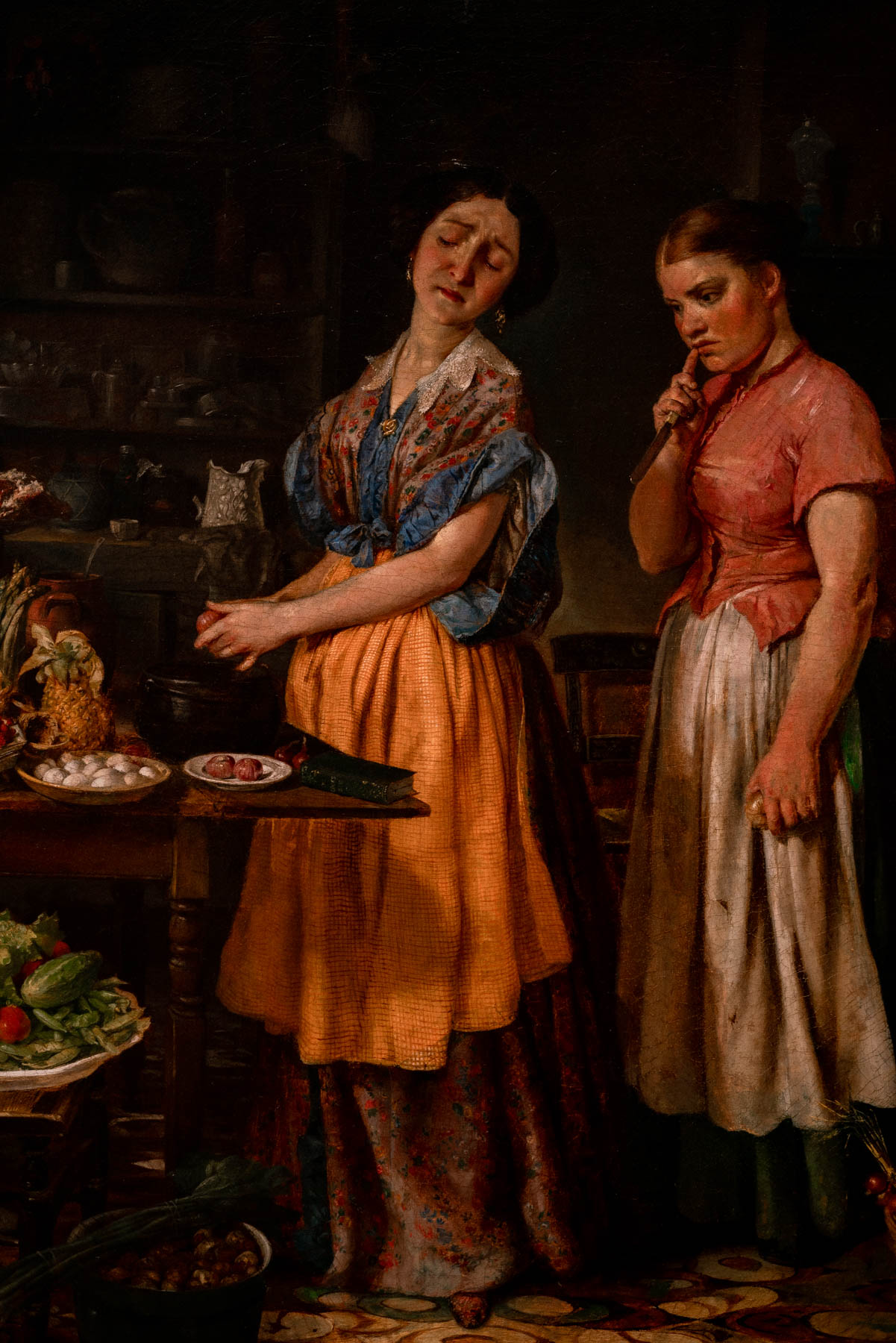
Portraits by Lily Martin Spencer
Spencer was a talented painter that portrayed the reality of male-female relationships in a patriarchal society. The Met is home to one particularly fascinating collection of her paintings:
- Young Husband: First Marketing
- Young Wife: First Stew
These two famous paintings at the Met hang side-by-side and depict the early years of marriage in a humorous way. The husband is asked to get groceries from the market, something he has clearly never done before. He’s embarrassed and attracts gazes from amused onlookers.
The second portrait is equally amusing and picks up where the last portrait left off. The wife attempts to make a stew from the random jumble of groceries her husband brought home (notice the pineapple?). The wife wearily peels an onion while her perplexed helper looks on.
Spencer sought to illuminate the social anxieties at the time — running a household efficiently, which she does flawlessly. In my opinion, these are some of the most beautiful paintings at the Metropolitan Museum of Art.
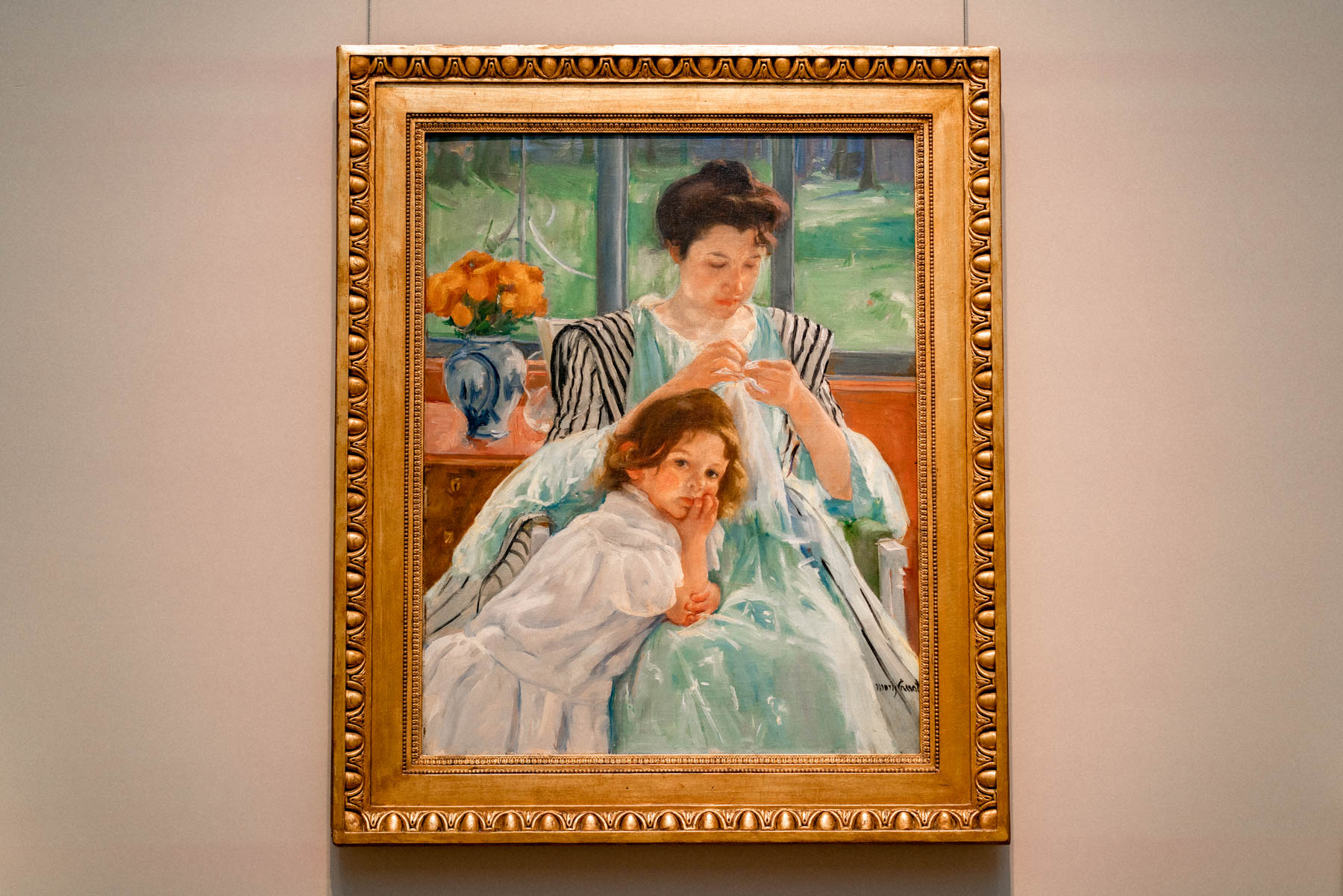
Young Mother Sewing
Mary Cassatt was an American painter that befriended and apprenticed under Edgar Degas (The Dance Class & Little Dancer). Cassatt’s focus was portraying the domestic life of women, mainly the intimate bond between mothers and children.
Her portrait of Young Mother Sewing is a must see at the Met. The painting is vivid, inviting and calm. The child’s tranquil gaze is piercing, while the mother sews undisturbed. There’s no denying that Cassatt has a way of making mundane daily tasks feel romantic. Her expertise in pausing time to reflect on the importance of childhood makes her paintings so tender.
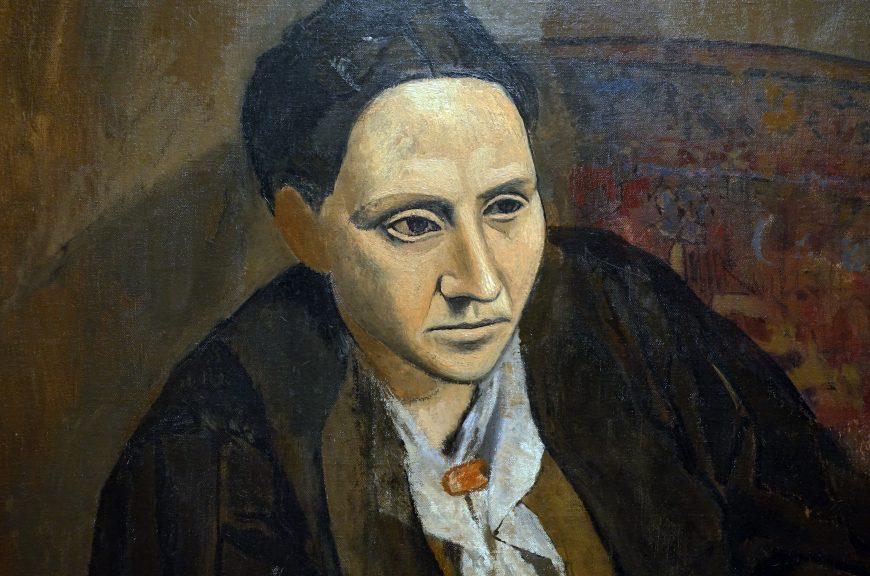
Portrait of Gertrude Stein by Pablo Picasso
Famous American author Gertrude Stein was an early adopter of European art and would often host world-renowned European artists in her Parisian apartment. She befriended Pablo Picasso, Pierre-Auguste Renoir and Henri Matisse, among others.
Picasso’s success is often partially attributed to Stein’s friendship because she encouraged his talent and supported him by purchasing three painting while he was living in poverty. Picasso’s portrait of Stein is a touching affair, his adoration and respect for the subject is obvious.
This portrait is special for two reason: It’s one of Picasso’s final paintings during his Rose Period (before he transitioned to Cubism) and Stein cherished the portrait so much that she held onto it until her death.
The portrait was bequeathed to the Museum of Modern Art before being transferred to The Met. Today, it’s considered one of the most famous paintings at The Metropolitan Museum of Art in New York City.
List of Famous Art at The MET in New York City (Post Overview)
In summary, here’s the best things to see at the Metropolitan Museum of Art in NYC:
- Self Portrait with a Straw Hat
- The Dance Class
- Washington Crossing the Delaware
- Rembrandt Self-Portrait
- Aristotle with a Bust of Homer
- Bridge Over a Pond of Water Lilies
- A Sunday on La Grande Jatte
- Vermeer Paintings
- The Death of Socrates
- The Temple of Dendur
- Human-Headed Winged Lion
- The Greek and Roman Sculpture Court
- The French rooms
- Ugolino and His Sons
- Young Mother Sewing
- The Denial of Saint Peter
- Gertrude Stein
- Garden at Sainte-Adresse
- The Thinker
- Arms and Armor
What to See at The Met in 2 Hours
If you’re looking for the best things to see at The Met in 2 hours, I suggest visiting the following pieces in order:
- The Greek and Roman Sculpture Court
- The Temple of Dendur
- Washington Crossing the Delaware
- Self Portrait with a Straw Hat
- A Sunday on La Grande Jatte
- Bridge Over a Pond of Water Lilies
- Ugolino and His Sons
- Arms and Armor
Visiting the Met (FAQs)
What is the most expensive artwork at The Met?
In 2004, The Metropolitan Museum of Art purchased a devotional panel of the Madonna and Child, which was the last painting by Duccio di Buoninsegna. The artwork was purchased for $45 million, making it the most expensive artwork at the MET.
How long should you spend at The Met NYC?
A proper visit to the Met can easily last 3-5 hours, but for most of us, looking at art for more than 2 hours feels like an exhausting task. As such, unless you’re an avid art connoisseur, I recommend planning to spend 2 hours visiting the Met. You should feel excited to return a second time, rather than feel drained as you leave the musuem.
Can you bring water into the Met NYC?
Yes, you can bring a water bottle with you, but it must be secured in a plastic container.
Related Articles:
10+ Great Museums for Kids in New York City (Fun & Educational)
30 Best Things to Do in New York City (For First Time Visitors)
15 Exciting Museums in New York City (& What to See at Each)
Interactive Museums in New York City (You Need to Know About!)
25 Thought-Provoking Facts About NYC You May Not Know (Yet)
Cheers!

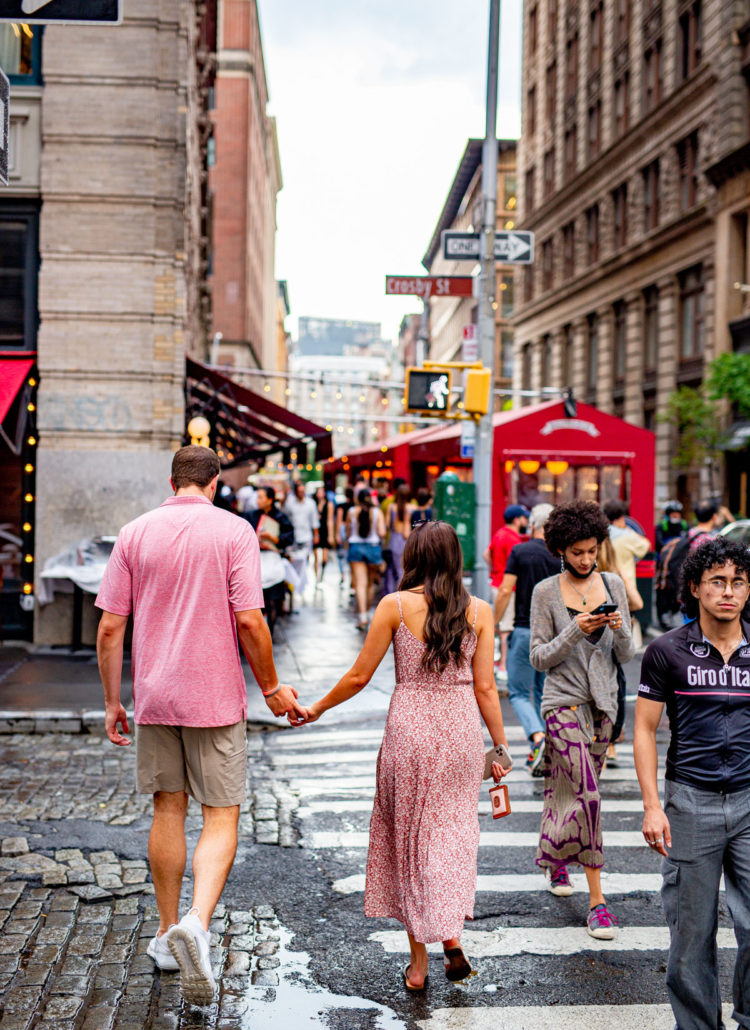
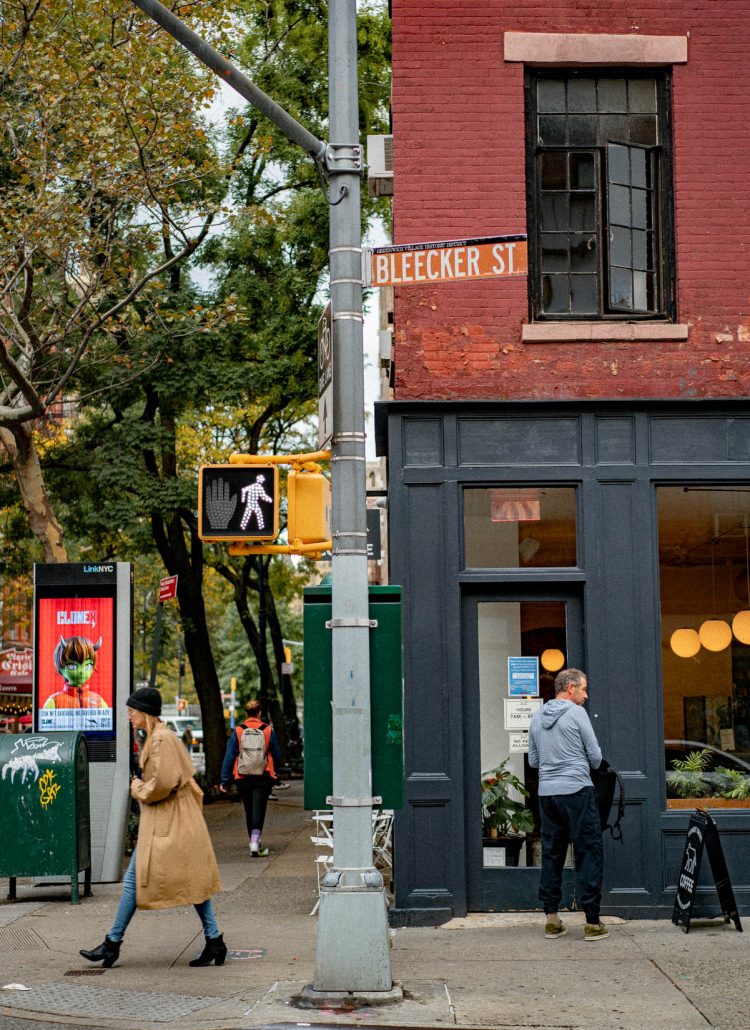

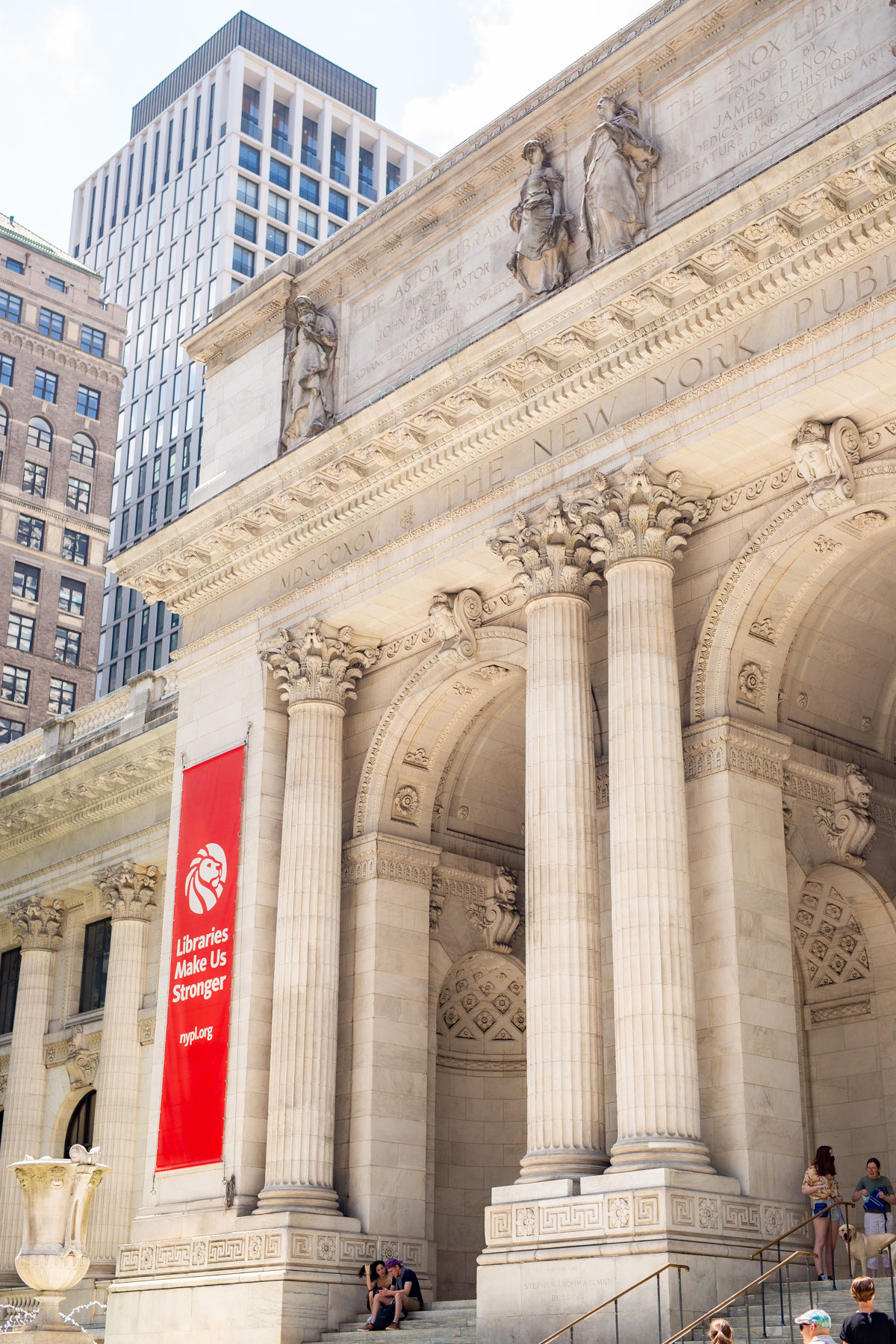
This is not a bad list. However, El Greco’s View of Toledo is one of the seminal works of Western Painting and should be included.
@Kevin, wow, thanks for letting me know about this painting (had no idea)! I’ll check it out on Sunday.
The Seurat painting at the Met is “Study for ‘A Sunday on La Grande Jatte'”. It is not the final painting (which resides at The Art Institute of Chicago”, and does not reflect true pointillism, a term coined for the final work, as this version uses tiny strokes as opposed to the dots used in his more famous piece.
Jane, thanks so much for this helpful information! I bet readers will find this very helpful. 🙂 Cheers!
Thank you for the detailed explanation. Much appreciated. Just a suggestion: if you can add the gallery number that’d be most helpful! Thanks again and cheers.
Hey Justin, we’ve linked to the Met’s official map to make it easier to locate the paintings, thanks for your feedback!
This is a fantastic list – Thank you for the details about the works – Have you ever considered doing a tour?
You are too kind! I’m so happy to hear you found the list helpful (it was a lot of fun to research/write about the art at the Met). I’ve never considered doing a tour, but please don’t hesitate to ask any questions that come up, I’m happy to help!